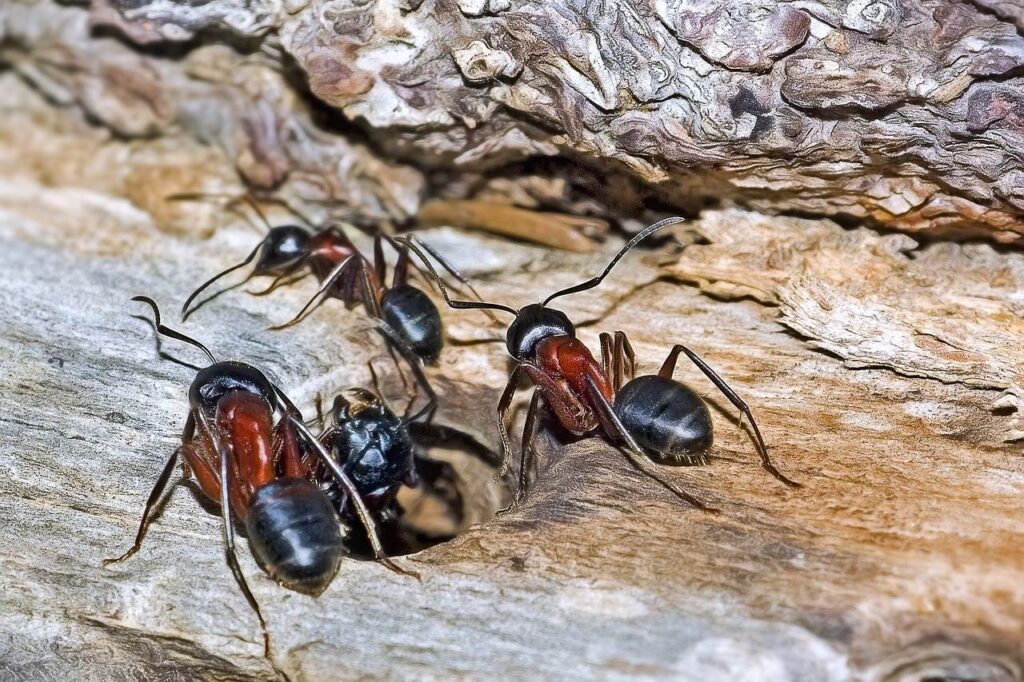If you’ve noticed wood damage around your property, your first thought may be that you have termites. However, your issue could just as easily been caused by carpenter ants.
Carpenter ants, like dry-wood termites, will nest in wood structures, such as trees, wood constructed buildings, and more. They chew hollow passageways in the wood to thrive and build their nests. Unlike termites, carpenter ants will simply hollow out the wood as opposed to eating it.
It is very common for carpenter ants to be mistaken for other types of ants and termites. Proper identification is important to determine the best treatment strategy for any pest problem.
ant control
What Are Carpenter Ants?

Carpenter ants are the biggest ants of all the ant types. Workers will typically be between 3/8″ or 1/2″ long and the carpenter ant queens can even grow to be 1 inch long! Like all other ants, they have six legs, an egg-shaped segmented body and antennas. Black carpenter ants are the most common, but some ants are also yellow, orange, tan, dark brown, red, light brown, or a combination of black and red.
When carpenter ants are ready to expand their colony, they will emerge as winged ants called swarmers. These swarmers are typically not produced until the colony is at least a couple of years old. If you spot swarmers around your property, it is typically a sign of a nearby infestation. These swarmers are often mistaken as termites. It’s important to seek out professional help to determine positive identification of the pest problem.
Although carpenter ants are typically found outdoors in heavily wooded areas, they can also make their way onto your property as well as into your home. Around your property, they can be found anywhere there is moist, decaying or fungus-ridden wood, such as in tree stumps, on roof overhangs, below windows, and on decks and porches. Meanwhile, once inside your home, they also look for soft, rotting, or hollowed-out wood structures to build their nests.
Even though carpenter ants will chew into wood, they don’t actually eat it. They lack the digestive protozoa to break down the cellulose found in wood. The carpenter ants diet mainly consists of fruit juices and other insects, dead or living. Outdoors, they will seek out ripe fruit and aphids to harvest honeydew (a sweet liquid produced by aphids). Carpenter ants will even tend to the aphids, protecting them and helping them thrive so that their honeydew remains a constant food source for the colony. Indoors, they will get into just about anything you eat or even your pets food. They are good at finding scraps, crumbs and spills that may go unnoticed.
carpenter ant
Do Carpenter Ants Cause Damage?
Since carpenter ants gnaw into wood, they can cause significant structural damage or ruin a structure’s aesthetics. Wood that they next in is hallowed-out and can weaken the wood from the inside. After some time, as the infestation continues to spread and more colonies begin to emerge, it can cause substantial structural damage.
All wood they carve to create the galleries is removed. One way to determine if you have carpenter ants is to observe the outside of the holes for mounds of wood shavings, insect carcasses, and other debris.
Treating For Carpenter Ants
If your property has overhanging tree branches that touch the building, you may be more susceptible to carpenter ants as they will use the branches as a way to make their way onto and inside your property. Properties with leaks are more prone to moisture issues, which can also attract carpenter ants. Open spaces around utility wires and pipes outside your property also provide an open invitation to carpenter ants.
It’s a good idea to seal all openings and gaps around your property (careful not to cut off ventilation) and keep all tree branches trimmed back. You should also repair, replace, or discard moist, rotting wood structures around your property to discourage carpenter ants from seeking them as shelter.
Unfortunately, once carpenter ants are well-established, they can be difficult to control because just one colony can contain more than 40,000 workers. They are also known to branch out into other colonies, which means if wood damage is present, it most likely caused by more than one colony present in the structure. At the first sign of carpenter ants, which includes small, thoroughly cleared out holes on the surface of wood with sawdust piles underneath, or maybe even workers searching for food in or around your property, it’s time to call a professional to help.
If left untreated, carpenter ants can cause considerable structural damage, which can render your structure unsafe. Don’t hesitate to address the issue when the problem arises.
ant control – yuba city pest control
We Would Love to Hear From You Soon!
